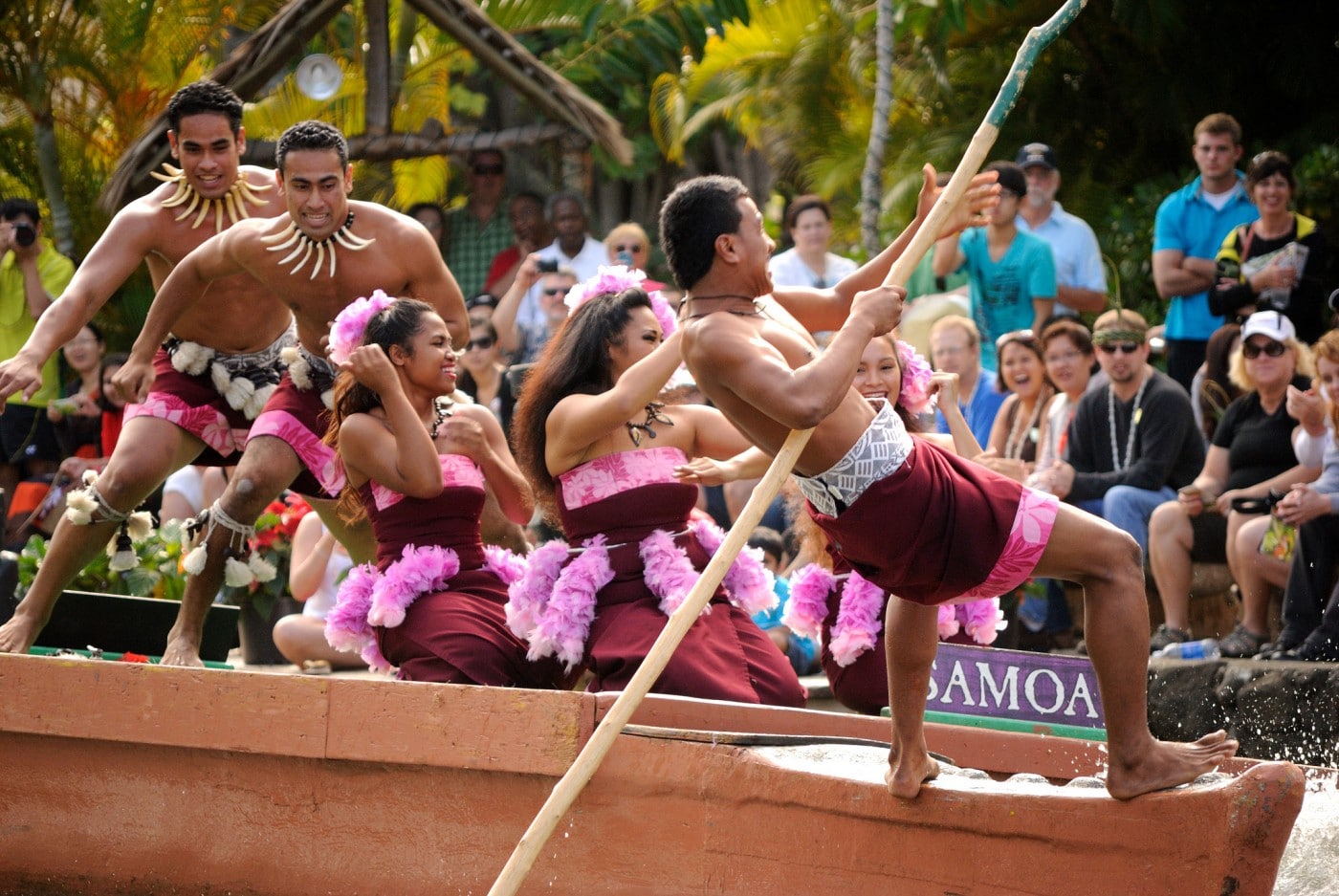[wide]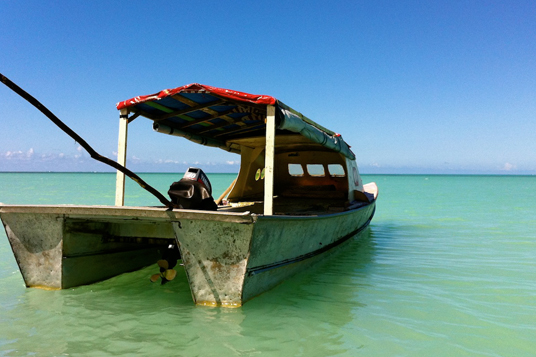 [/wide]
[/wide]
Call Samoa the country of sarongs. On this group of nine volcanic islands, about 2,600 miles southwest of Hawaii in the South Pacific, even the police wear what are called lava-lava instead of pants. First colonized by Germans as German Samoa, then controlled by New Zealand at the start of World War I, it was at that time re-classified Western Samoa. In 1962 the country gained its independence and today, in the “fa’a Samoa,” the Samoan way of life is a laid back one with most families owning their own land. Completely surrounded by coral reef and clear turquoise water, it’s is a perfect off-the-beaten-path pick in the paradise of Polynesia.
I spent a week exploring the islands of Upolu, Savai’i and the small gem of Manono and still feel like I barely made a dent in what’s on offer. From private beach coves, diving, snorkeling, surfing, sea kayaking and more, you can easily build a dream trip to Samoa and with a currency rate at about 2.5 to 1, have paradise for less than half the price. Here’s how we found ours.
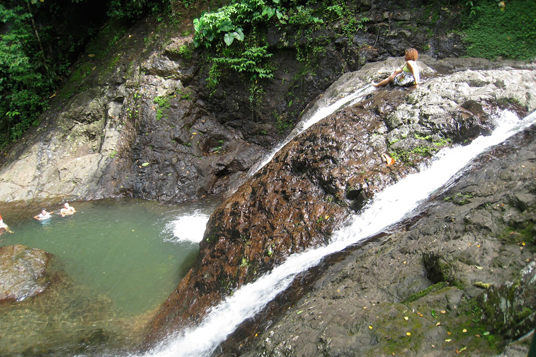
THE NATURAL WONDERS OF UPOLU
After landing at the Faleolo International airport, we made our home base in Apia, Samoa, on the north coast of Upolo. From here each day, our guide drove us along the small two-lane roads that circle and cross the island. My tip: Rent a car at the airport to take in the scenery (from $80 to $160 Samoan tala a day, about $35 to $75; they drive on the left side). You’ll get to see the Samoan fale homes—open-air wooden structures where locals meet, relax and sleep—an abundance of churches, roaming cows, dogs and pigs and families going about their chores among the palm trees, plumeria, birds of paradise, hibiscus and what the Samoans called teuila, their national flower.
We stayed our first night at Aggie Grey’s Hotel in Apia, which is decorated with black and white photographs of American soldiers visiting during the second World War. We also caught their weekly cultural show to see some traditional Samoan dance. For the women, it’s an elegant, poised and gentle dance similar to a slow, hip-swirling Hawaiian hula; the men’s slap-dancing performances resemble New Zealand Maori warriors. Together, it set the perfect tone for our trip.
Downtown Apia is small and colorful, with hotels, restaurants, markets and bars along Apia Harbor. We hit the Apia Flea Market, a covered market on Mulinu’u Road that sells dresses, sarongs, T-shirts, crafts, jewelry, kava bowls and other souvenirs. (My tip: Consider saving this stop this until the end of your trip, when you know what you want to take home). I bought two sarongs here, for $10 and $15, followed by my first taste of the Samoan sense of humor: “Sarong $25,” the vendor said. Then, pointing to the young man beside her in the stall, “and the man come free. Buy sarong and take the man for free.” As we laughed, I realized I should get used to this. Samoans are extraordinarily friendly—and my first stop the next morning at a natural wonder became my first clue as to why.
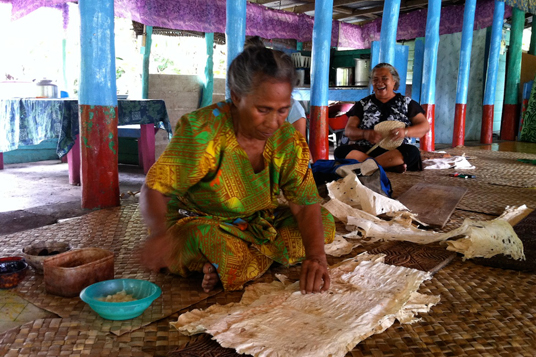
About twenty-five minutes inland from downtown are the Papaseea Sliding Rocks (entrance fee about $1; most natural playgrounds like this are on private property, so find the family member collecting entrance fees). Tucked within a lush, shady jungle and down a hill of stairs, I sat at the top of the first natural waterslide, my stomach in knots for five minutes, before some affable Samoan boys in the crystal water below coaxed me. “Five, four, three!” they shouted. I gave in at “one” and took the quick gulp-worthy slide down the slippery rockface, plunging into a crystal clear freshwater pool below. Man, it was fun. We kept sliding for hours.
Along the way to our next destination, we bought freshly cracked coconuts with straws from a young boy on the road’s edge for $1 tala each, or 40 cents. Then, twenty minutes east of Apia, we arrived at the Piula cave pool, a natural freshwater swimming hole on the property of the Methodist Theological College, near the town of Fusi, where palm trees leaned toward the water as if checking their reflections and pigs roamed the properties drinking from streams. After swimming under the sun with schools of small fish, we swam into the cave, about fifty feet into darkness. The super brave—or slightly insane—can also seek out the submerged tunnel about five feet underwater that connects with a smaller cave pool beside it. Me? I was happy swimming on the surface, thank you very much.
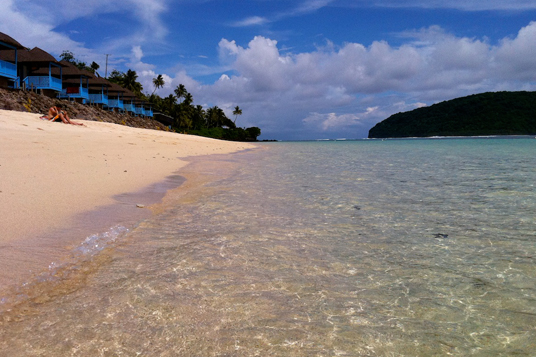
We then drove southeast along the winding and stunning Le Mafa Pass Road. We got a gorgeous view of the distant ocean and rolling green valleys, as mist settled into pockets in the hills. The closer we got to the coast, the more locals we saw – men walking with baskets of coconuts bobbing from their shoulders, a woman lying down in her fale home and fanning herself with a straw fan, a family playing volleyball on their front lawn. There are also modern concrete homes among the fales and contemporary life has come with them. We also saw teenagers texting on Smartphones and televisions flickering from open fale homes after dusk.
One highlight that first afternoon was Lalomanu beach with smooth white sand and a view of the wild green Nuutele island in the distance. With a turquoise blue sea that was bathwater warm, this was as pretty a beach as I’ve ever seen. Steps from the water, we had a healthy lunch at the Taufua Beach Fale restaurant. My tip: Order the grilled masi masi fish with rice and cut pineapple for just about $5; I had mine with a cold, local Vailima beer for another $3. If you’re adventurous, stay in one of the open Taufua beach fale huts right on the sand for a true bargain (about $36 per person, double, for a mattress on the floor, pillow, mosquito net and breakfast and dinner at community tables) There are also closed fales available, with walls and beds for about $44 per person).
Our next stop was a “Holy Cow” moment for me. The To Sua trench translates as “big hole” in Samoan (entrance fee: about $4) and that’s just what it is. In the middle of a gorgeously manicured private estate lies a gaping hole in the grass encircled by ferns (be warned, there are no railings). At the bottom? A stunning bright turquoise pool about one hundred and fifty feet down. The cool saltwater trench that gurgles from the incoming ocean tide is accessible by a palm-sweating climb down an oversized wooden ladder that’s a little scary but so worth it. If you’re faint of heart, stroll to the edge of the cliffs and sit in one of the small wooden fales for a peaceful view of the ocean waves below.
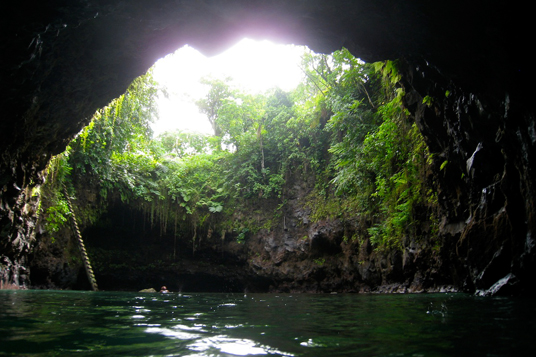
We stayed the night at the very modern Tania Tusiyala Hotel which reminded me of an upscale boutique hotel in South Beach, and the next day, visited the Robert Louis Stevenson museum, the writer’s beautiful former home at Villa Vailima that feels much like a Southern plantation (tour is about $6 dollars). Stevenson is still buried there, at the top of mountain. After visiting his grave via a hearty 30-45-minute hike up a trail shaded by jingle and breadfruit trees, we took a rewarding dip in a shallow swimming hole at the bottom, beside a small waterfall.
THE SERENE SAVAI’I
On our third afternoon, we drove onto the ferry at Mulifanua Wharf to get to the island of Savai’i. The ferry runs every two hours, from 6 a.m. to 4 p.m. and costs $5 dollars for crammed standing room outside. My tip: I highly recommend paying $20 for the guaranteed indoor business class seats with air conditioning and snacks; it’s $38 dollars more for the car, which you must pre-book, as it will fill up. After the one-hour ride, we settled into our private villa at the charming Siufaga Beach Resort. Just steps across the street, we took a kayak out on the clear water, then returned for a drink at the swim-up bar in the pool. I devoured the garlic fish for dinner at the open-air restaurant upstairs (around $13) to the swaying sounds of live Samoan music.
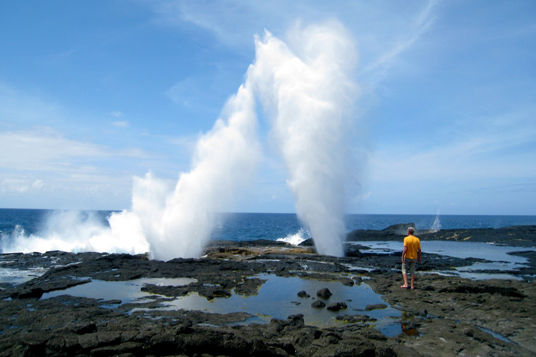
The next morning, we drove along the Nuu black sand beach to the natural wonder of the Alofa’aga Blowholes (also called the Taga Blowholes) a dramatic section of black lava rocks where, when the tide is high, water whooshes up through holes in the rock and rockets twenty or more feet into the air (entrance fee: about $2.50). Our guide then took us to a local’s home to view the making of siapo, the Samoan version of tapa bark art, made from the bark of the mulberry tree and painted with ink made from mangrove and plantain trees. We drank cups of warm natural cocoa while watching the women work and I bought a piece of art that now hangs on my bedroom wall (about $12 for one 11” x 14” piece). After waiting out an afternoon rain shower, we visited the pretty Afu aau waterfall ($2.50 per person). My tip: Stop at a local market before hitting the swimming hole here so you can picnic on crackers and fruit in between swims.
On Sunday, we had a traditional toonai lunch cooked on the outdoor umu oven, over volcanic rocks and covered with banana leaves. After hand-weaving our own basket mailo plates from palm leaves, we feasted on freshly caught and steamed laea (blue parrot fish), grilled octopus, lamb ribs, and palusami made from taro leaves wrapped around coconut cream. Wherever you are in Samoa on a Sunday, ask your hosts how you can partake in a similar meal.
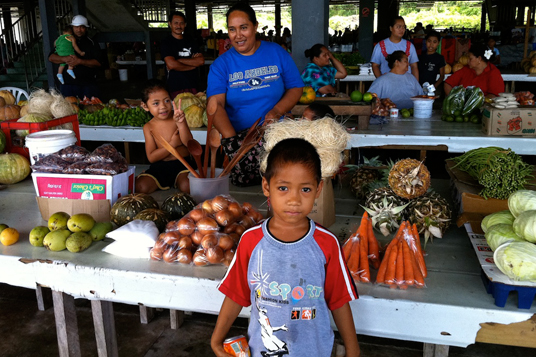
THE QUAINT MANONO
The final stop on our Samoan adventure was a half-day trip to Manono Island that is so small, you can walk it end to end in one hour (we arranged this through Samoa Scenic Tours, which runs trips like this all around Samoa). After puttering over aqua water in a covered motorboat, we pulled up to the tiny green island. “Everything will be safe in the boat,” said our guide, “unless it sinks.” There it was again, that Samoan sense of humor.
After a short stroll, we were invited to experience a traditional family kava ceremony, in which we drank the powdered root of the kava plant mixed with water. “Manuia!” we each said before sipping the subtle filmy white liquid, then a thank you, “Faa fetai,” to our host after we did.
At the end of our trip, we treated ourselves to a stay at the gorgeous Coconuts resort back on the island of Upolu (My tip: stay in one of the brand new enclosed beach fales with unobstructed views of the water; cost is about $326-$369 per night, with a three-night minimum). Sitting under a palapa umbrella by the pool with my feet facing the ocean, I took in the palm dotted coastline, watched crabs scuttling on the black lava rocks down to the sand and heard nothing but chirping birds and waves crashing far out on the coral reef. I’ve rarely felt so at peace as I did during my time in Samoa, a country that mixes an easy feeling of roughing it with tropical amenities. In just one week, I, too, was smiling like a laid-back, happy local.
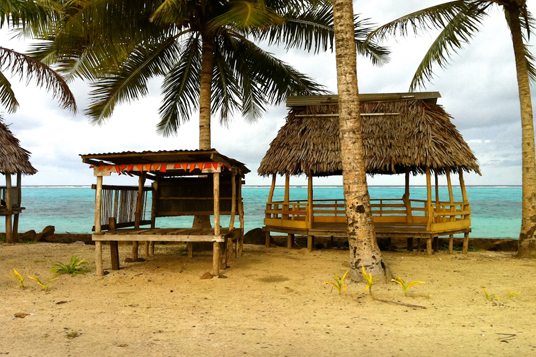
Where To Stay
Aggie Grey’s Hotel – Stay in a bungalow named after Hollywood stars like Marlon Brando and Gary Cooper, who both visited the hotel in the 1940s. Rates average $160 per night. Beach Road, Apia, +685 22880; http://aggiegreys.com/ [Note: Aggie Grey’s also has a resort option near the Faleoleo airport]
Coconuts – Nearly two years after the tsunami wiped out the resort on southern half of Upolo island, this resort has rebuilt some modern beach-facing walled fales and two-story villas, both with delectable natural rock waterfall showers. Rates average $329/night for fales, $399-$999 for villas per night. South Coast, Maninoa Village, Apia, US Toll Free: 866-726-6268; http://www.coconutsbeachclubsamoa.com/
Le Lagoto on Savai’i. This modern small resort has enclosed beach fale-style bungalows right on the beachfront, where you can float all day in the infinity pool and snorkel in the calm blue lagoon. Rates average $250-$280 per night. North coast, Fagamalo, Savaii, Savaii, (00685) 58 189; http://www.lelagoto.ws
Where To Eat
The restaurant at Le Lagoto Resort. Scrumptious local flavors in an open air setting on the water. Try the chicken noodle soup made with coconut cream. Meals average $40. North coast, Fagamalo, Savaii, Savaii, (00685) 58 189; http://www.lelagoto.ws
Encounter. A small local spot just five minutes from downtown Apia that offers cheap eats. The masi masi fish in tomato onion sauce (what we call mahi mahi) is to die for. Meals average $10. Falealili Street, Upolu.
Mika’s restaurant at Coconuts resort. Sweets fans should not miss the Samoan panakeke for breakfast, like small beignets with rum bananas you dip in syrup. Meals average $35. South Coast, Maninoa Village, Apia, Upolu; US toll free: 866-726-6268; http://www.coconutsbeachclubsamoa.com/
What To See
To Sua Ocean trench – essentially a big hole in a lush green lawn about one hundred and fifty feet deep near the ocean’s edge on Upolu’s southern coast.
Alofa’aga (Taga) Blowholes – Spouting rockets of ocean water shoot through holes in the black lava landscape on the island of Savai’i. Arrange a full-day trip to the blowholes through Samoan Scenic Tours. http://www.samoascenictours.ws/
Papaseea Sliding Rocks. A perfect example of Samoa’s still unspoiled nature, just fifteen minutes from downtown Apia, you can frolic away an afternoon on one of the small natural waterslides. Papaseea Road, Upolu.

